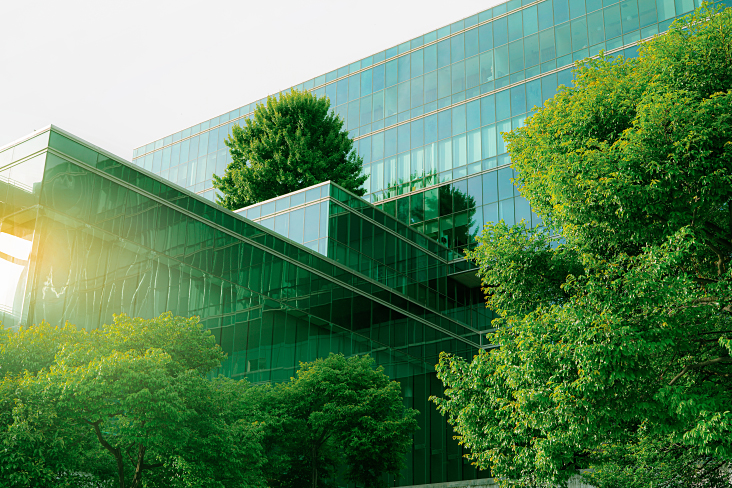RTLS-Enabled Smart Buildings and Offices Generate ROI for Owners
What Is a Smart Building?
A smart building uses technology-based systems, services and technologies to optimize its performance. In these facilities, systems like security and ventilation use network sensors that provide constant information about their conditions. This provides a variety of benefits for building occupants such as cost savings, risk mitigation and overall safety.
According to data from MarketsandMarkets, the global smart building market will grow to nearly $121.6 billion USD by the end of 2026. What’s driving the demand? Unsurprisingly, the biggest factors are things like efficiency, from operational to energy, and security, from IoT vulnerabilities to access control.
But at the end of the day, buildings are only as smart as the businesses that operate within them. If you’re not thinking about how to improve your workplace from the above-mentioned vantage points, you’re taking an unnecessary risk.
Every organization — from healthcare and manufacturing to education — can benefit from adopting a real-time location systems (RTLS) infrastructure as part of their brick-and-mortar facilities.
What Is RTLS?
Real-time location systems (RTLS) technologies automatically identify and track the location of objects and people in real time, typically within a building or other contained area. A robust RTLS approach will provide actionable data that can be used in multiple ways, including enhancing efficiency, safety and asset management.
Coupled with smart building tools, RTLS helps companies enrich the value of their technology and asset investments in a number of ways, from physical access management to asset tracking and more.
How Do Smart Buildings Use RTLS?
Used together, smart buildings and RFID-based RTLS technologies represent a powerful solution for any business. Smart buildings typically use Internet of Things (IoT) sensors, data analytics and automation technology. Then, RTLS reference points, which can be either transmitters or receivers, are spaced throughout a facility. When all these tools are combined, organizations can more easily monitor and assess processes and conditions within a building with precision and ease.
Operational Efficiencies and Cost Savings for Smart Building Owners and Lessees
Buildings that are highly-rated on a sustainability or green scale offer greater ROI in terms of costs savings from operational functions such as HVAC, electrical usage and even recycling.
Throughout the commercial and office facilities industry, there are certifications such as LEED certification (Platinum being the highest) that can indicate how well-designed and efficient a building is. LEED buildings use 25% less energy and have 19% lower maintenance costs than non-certified facilities.
According to the United States Green Building Council, a LEED-certified building meets the following criteria:
LEED-certified buildings save money, improve efficiency, lower carbon emissions and create healthier places for people. They are critical to addressing climate change and meeting ESG goals, enhancing resilience, and supporting more equitable communities. LEED categories can also contribute toward meeting the U.N.’s Sustainable Development Goals.
This is all well and good for newer construction that takes into account these design concepts, but for existing buildings, retrofitting them to meet these requirements incurs both time and costs.
In lieu of these building upgrades, ostensible off-the-shelf technologies such as RTLS solutions that HID provides can mitigate some of these costs through activities such as:
- Location tracking
- Sustainability
- Workplace safety
Location Tracking
An RTLS’ primary function is to locate things. No matter the industry, RTLS can streamline the movement and tracking of objects and employees, within a building or place of work. RTLS is especially useful in large buildings like warehouses and office campuses.
For example, employees in manufacturing and logistics facilities are responsible for large volumes of assets. Much of their time is spent manually tracking equipment, work orders and assembly-line production. RFID technology can provide these workers with the exact location of pallets, materials and equipment, increasing operations and reducing overtime work.
Condition monitoring sensors can also track when the environment around an asset is harmful. For example, many manufacturing warehouses need to maintain specific temperature ranges so that machinery doesn’t become too warm or too cold. This technology can alert workers when something isn’t right so potential problems can be avoided. Furthermore, condition monitoring can reduce equipment downtime by enabling best practices such as predictive maintenance.
In terms of costs, SoftwareTrends estimates downtime (or time spent locating assets) can cost up to $7 per second or $25,000 an hour!
Some of the costs are because of:
- Attempting to locate assets manually
- Billing disputes with customers over lost assets
- Certification requirement delays for equipment
- Decision-making holdups due to lack of real-time information
These issues and more can be mitigated in a smart building setup with location tracking deployed throughout the facility regardless of the age and design of the building.
This, in turn, generates ROI for the facilities’ owners and lessees.
Maximized Sustainability via RTLS
Sustainable workplaces attract the best talent, are more productive than average and create trusting relationships with their consumers. RTLS can help offices across various industries maximize sustainability efforts by decreasing energy and material waste.
RTLS’ automation capabilities help reduce manual errors and repetitive work. This reduces the quantity of materials that are needed to complete a job — paper, water, metal, etc. — resulting in a significant drop in waste. Not only does this lessen an organization’s environmental footprint over time, but it also reduces production costs.

RTLS Enhances Workplace Safety
Most organizations strive to ensure their employees feel safe within their workplace and are appropriately equipped to do their jobs. Employees want safety initiatives that ensure internal compliance and guard against forced entry and theft. RTLS does both and can be used to:
- Identify personnel who may be non-compliant with safety rules
- Enforce equipment controls to protect workers during emergencies (i.e., it can alert workers if a machine has malfunctioned and can help prevent it from turning on)
- Log who accesses what equipment
- Track hazardous materials throughout a building
- Set perimeter boundaries for assets that automatically alert when objects move beyond them
- Send discreet panic alerts during emergencies
While the details vary by industry, office size and number of employees, a safer workplace is a happy workplace.
In this post COVID-19 and digital transformation era, business intelligence data is becoming increasingly invaluable to organizations around the world. The ability to understand our spaces, environment, people and assets is only going to increase over time. Our solutions are agile, scalable and address a multitude of organizational use cases.
Kevin Mercer, Global Director of Sales - IoT Solutions, HID
Integrating RTLS within a smart building or legacy facility opens the door to better efficiency, safety and automation — for businesses and employees. But understanding the benefits is just the first step. Implementing them requires a deep dive into business processes and the physical workspace. Working with a partner, such as HID, that has experience designing and deploying RTLS solutions in a plethora of industries can offer significant savings in bottom line and overhead costs.
For a deeper dive into how RTLS-enabled smart buildings benefit organizations and employees, read our executive brief, Beyond Access Control: Five Tips for a Smarter Building.
Nick Iandolo is an experienced Senior Editor Marketing Strategist specializing in Content Marketing and Corporate Communications Writing, primarily for market-disrupting technology organizations. His work has been featured in publications such as Morning Consult, NewDesign Magazine UK, SmartCard Identity News, and Construction Outlook. Nick is also a Spartan Race athlete, and lives just outside of Boston Mass with his wife, daughter, and Golden Retriever.
